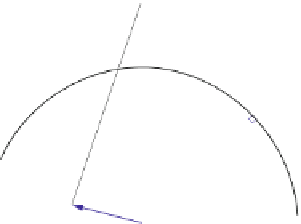Geoscience Reference
In-Depth Information
dh
clock
Δ
L
z.
mf(e)
Δ
L
z
dh
.
sin(e)
e
Fig. 8
Different elevation-dependence of the tropospheric delays (
red
), clock values (
green
), and
height components (
blue
). Whereas the partial derivatives for the estimation of clocks and height
components are strictly 1 and sin
(
e
)
, respectively, the partial derivative for the estimation of the
zenith delay is the mapping function which is approximately 1
/
sin
(
e
)
, but is not perfectly known
(modified from Rothacher et al. (
1998
))
station heights are dependent on the elevation angle only, but whereas the partial
derivatives w.r.t. the clocks (=1) and the station heights (=sin
) are exactly known,
the partial derivatives for the zenith delays (i.e. the mapping functions) are only
known with a limited accuracy. Consequently—via the correlations between zenith
delays, station heights, and clocks—any imperfection of the mapping function will
also result in errors in the station height estimates (and clock errors).
Considering Eq. (
118
) we find the following relationship: If the mapping function
is in error (too large), then the estimated zenith delay
(
e
)
L
z
Δ
is too small, because the
observed tropospheric delay
does not change. Consequently, the estimated
station height goes up. Niell et al. (
2001
) set up a rule of thumb specifying that the
error in the station height is approximately one third of the delay error at a cutoff
elevation angle of 7
◦
. Böhm (
2004
) revisited this rule of thumb for VLBI analysis
(and a cutoff elevation angle of 5
◦
) specifying that the station height error is about
one fifth of the delay error at the lowest elevation angle. This is close to the value
0.22 found by MacMillan and Ma (
1994
). The corresponding decrease of the zenith
delay is about one half of the station height increase.
Δ
L
(
e
)
4.2.1 Azimuthal Symmetry: Mapping Functions
Assuming azimuthal symmetry of the neutral atmosphere around the station (i.e. at
a constant elevation angle the delay is not dependent on the azimuth angle of the
observation), the approach as described in Eq. (
119
) is used (e.g. Davis et al.
1985
)
L
h
·
L
z
w
·
Δ
L
(
e
)
=
Δ
mf
h
(
e
)
+
Δ
mf
w
(
e
).
(119)
Δ
is the total path delay of the microwaves in the neutral atmosphere and
e
is the elevation angle of the observation to the satellite or the quasar (vacuum or
geometric elevation angle).
L
(
e
)
L
h
and
L
z
w
are the a priori zenith hydrostatic and the
Δ
Δ
















